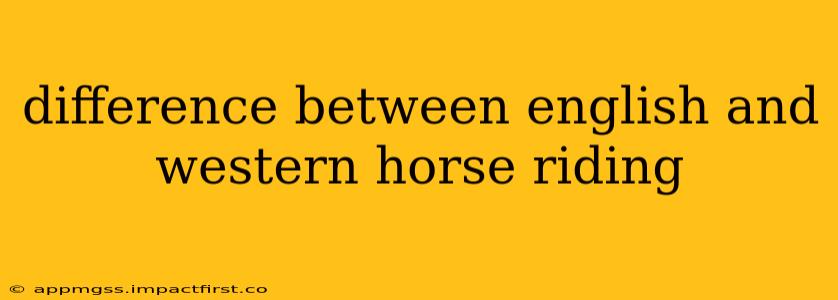Horse riding, or equestrianism, boasts a rich history and diverse styles. Two of the most prominent are English and Western riding, each with distinct traditions, equipment, and riding techniques. Understanding the key differences can help aspiring riders choose the discipline that best suits their interests and goals. This detailed comparison will delve into the nuances of each style, answering common questions riders often have.
What are the Main Differences Between English and Western Riding?
The most striking differences between English and Western riding lie in their seat, tack (equipment), and riding style. English riding emphasizes a close contact seat, focusing on balance and subtle aids to guide the horse. Western riding, conversely, employs a deeper, more relaxed seat, often using a more assertive style of communication. This difference stems from their historical origins and the types of horses and activities they were initially developed for.
What is English Riding?
English riding, encompassing various disciplines like dressage, jumping, and eventing, originated in Europe. It emphasizes balance, precision, and elegance. Riders maintain a close contact with the horse, using subtle leg and rein aids to achieve precise movements. The emphasis is on light contact and the horse's responsiveness to the rider's subtle cues.
Types of English Riding Disciplines:
- Dressage: Focused on precise movements and harmony between horse and rider.
- Jumping: Involves navigating courses of obstacles.
- Eventing: A triathlon of dressage, cross-country, and show jumping.
- Hunt Seat: An elegant style often seen in equitation classes, focusing on the rider's posture and form.
What is Western Riding?
Western riding, developed in the American West, is characterized by its relaxed posture, longer reins, and use of specific equipment. It evolved from the practical needs of cowboys working with cattle. Western riding prioritizes a strong, independent seat that allows the rider to maintain balance while performing tasks such as herding cattle or riding long distances.
Types of Western Riding Disciplines:
- Reining: Emphasizes precise maneuvers and a close partnership between horse and rider.
- Cutting: The horse separates a single cow from a herd.
- Roping: Involves catching cattle using a rope.
- Trail Riding: Focuses on enjoying scenic routes and navigating varied terrain.
- Pleasure Riding: A more relaxed style emphasizing the horse's smooth gait and the rider's comfortable seat.
What are the Different Tack Used in English and Western Riding?
The tack (equipment) used significantly differs between the two styles.
English Riding Tack:
- Saddle: Close-contact saddle, typically made of leather, designed for a balanced and close rider position.
- Bridle: Includes a snaffle or Weymouth bit for refined control.
- Boots: Tall leather boots for ankle support and a secure leg position.
Western Riding Tack:
- Saddle: Larger saddle with a deep seat and high cantle for stability and a more secure rider position.
- Bridle: Often incorporates a curb bit or a combination of snaffle and curb bits, allowing for more leverage.
- Boots: Short or tall boots with a slightly wider heel for better foot placement in the stirrups.
What are the Different Riding Positions in English and Western Riding?
The rider's position dramatically differs.
English Riding Position:
- Upright posture: The rider sits tall with a straight back and relaxed shoulders.
- Close contact: The rider maintains close contact with the horse's back and uses subtle leg and rein aids.
Western Riding Position:
- Relaxed posture: The rider sits deeper in the saddle with a more relaxed posture, allowing for a more independent seat.
- Longer reins: Longer reins give the rider more flexibility and control, allowing for greater balance and maneuverability in different terrains and situations.
What type of horse is best for English and Western riding?
While many breeds can excel in both disciplines, certain breeds are more commonly associated with one or the other. For example, Thoroughbreds and Warmbloods are often preferred for English disciplines, while Quarter Horses and Appaloosas are popular choices for Western riding. Ultimately, the horse's temperament, training, and suitability for the specific discipline are more important than breed.
Which Style is Right for Me?
The best style for you depends entirely on your personal preferences and goals. If you appreciate precision, elegance, and close contact with your horse, English riding might be a better fit. If you prefer a more relaxed riding style, enjoy working with cattle, or prefer a deeper seat, Western riding may be a more suitable option. Consider trying introductory lessons in both styles to determine which you find more enjoyable and engaging.
This detailed comparison highlights the significant differences between English and Western riding. Both disciplines offer rewarding experiences, fostering a strong connection between horse and rider. The choice is ultimately a personal one, based on individual preferences and aspirations.
